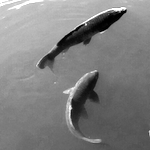Bats are the only extant organisms that can fly using highly flexible membrane wings. The bat's membrane hand-wing is stretched over a skeleton with multiple joints, and these joints allow complex wing maneuvers, enabling agile flight through complex environments. Understanding the fluid-structure interaction physics of the bat's hand-wing can provide fundamental design principles for bio-inspired micro aerial vehicles. In this work, we conduct a fluid-structure interaction simulation of the bat's wing using the bone joint kinematics of the actual bat from experiments. The structural solver is based on a spring-mass-damper system, where the spring network controls the in-plane and out-of-plane deformations. This solver is coupled with our immersed boundary method-based flow solver, ViCar3D. In our methodology, we divide the hand wing into elastic and inelastic components, with the elastic components comprising the joints and digit bones. The joint kinematics from a bat in free flight is used to prescribe the joint kinematics of our model within the simulation, and the elastic membrane is allowed to deform due to incoming flow. The interaction of the fluid flow and the flexible wing generates aerodynamic forces that support the flight of the animal. The aerodynamic forces exhibit a highly oscillatory behavior with a range of time scales. We employ the force partitioning method (FPM) to decompose the pressure-induced forces into vortex-induced, added mass-induced, viscous-diffusion-induced, and freestream-acceleration-induced effects. The two key contributors, in this case, are the vortex-induced and added mass-induced effects. Application of the force partitioning method to the FSI simulation dataset reveals that the oscillation in the aerodynamic forces is entirely due to added-mass effects associated with the flutter in the membrane. The vortex-induced effects, on the other hand, are primarily responsible for generating most of the lift. FPM is used to dissect further the role of wing flexibility and various vortex structures on the lift and thrust.

 PDF version
PDF version
